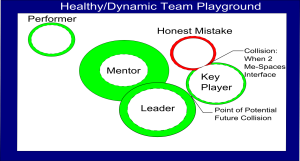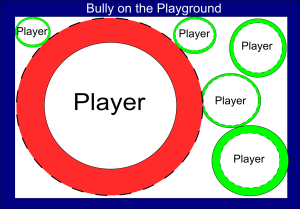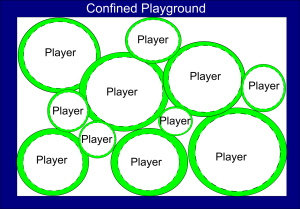In WorkSpace Model of Influence, all individuals are surrounded by 2 spheres within the organizational space. One sphere called the Me Space represents the amount of influence that the individual is choosing to wield at a given moment of time. If the individual chooses to intervene more, perhaps by making a suggestion, volunteering for a task or asking a question, the size of the Me Space grows. If that individual chooses to not intervene, the Me Space shrinks. The size of the Me Space is under the direct control of the influencer.
The other sphere can be designated the We Space. Just as there are boundaries to the organization, there are limits to how much influence the organization will allow you to have. An individual who hasn’t developed the requisite credibility on marketing, for example, will not have a great deal of influence on the company’s new marketing strategy. But a seasoned manager with a track record of increasing divisional performance will be listened to on a wide variety of topics. The We Space is the unstated judgment or consensus of the group of the amount of space that the group will allow the individual to safely occupy before developing resistance. The size of the We Space, therefore is based on the nebulous aggregate judgment of others. It is always unknown to the would-be influencer.
The influencer has the ability to define the limits of the Me Space. The boundary of the Me Space is defined by the choice to intervene or not to intervene. Interventions can take the shape of many forms. In this context, an intervention can be defined as any voluntary action that is taken to change the flow or bypass the course the group is currently taking. Anytime someone chooses to speak, to volunteer for a new assignment, to offer suggestions or initiate some new program, a person is choosing to intervene in the function and operation of a group. Any time someone chooses to redirect another there is a chance for a backlash in the form of resistance. It should also be clear that resistance could be harmful to the influencer. Regardless, each time one chooses to speak, volunteer or initiate something, one is choosing to expand one’s Me Space.
The We Space is entirely different. The influencer has no direct control on the size of the We Space. The We Space is defined by the amount of trust and comfort the group has in you. In determining the size of the we space, the group examines many aspects of the influencer.
The Destructive Zone
So long as one’s Me Space is within the boundaries of the We Space, we can expect the group to be generally supportive. It is natural for people to be generally supportive of those who are trying to improve things or make a positive impact on organizations. The group may be motivated to actively support the individual or simply give him or her the leeway to operate without hampering his or her efforts.
If, however, the Me Space is allowed to expand beyond the boundaries of the We Space, the interactions and interventions are actively destroying group trust and goodwill. To the extent that the Me Space extends beyond the We Space, we designate this as the Destructive Zone. In this configuration, there is an active pressure that works to deflate the We Space. In addition, the farther beyond the boundaries of the We Space the influencer operates, the greater the deflation pressure. So the farther and longer the influencer lives beyond the boundaries set for him or her by the group, the more influence that person wields diminishes.
Applying the WorkSpace Model
The WorkSpace model is a useful tool in modeling team and organizational dynamics. It is my hope that using this model will help provide an organization a context from which to begin discussions on how to better manage the use of influence in an organization.
To illustrate the use of the WorkSpace model, several scenarios are presented. The dashed line indicates the boundary of the Me Space and the solid line denotes the boundary of the We space. We will analyze each team in turn.
A Healthy, Dynamic System
 Below is an example of a playground of a pretty healthy team dynamic. First, there is a great deal of space available for people to naturally grow and to experiment. In fact, there may be a bit too much available space. This might highlight the need for new hires or it may highlight the need for establishing a bit tighter boundaries of the organization or team’s space.
Below is an example of a playground of a pretty healthy team dynamic. First, there is a great deal of space available for people to naturally grow and to experiment. In fact, there may be a bit too much available space. This might highlight the need for new hires or it may highlight the need for establishing a bit tighter boundaries of the organization or team’s space.
There are several types of people in this example. There is one player named “Performer” in the upper left hand corner. One could imagine this person being the competent IT manager who quietly manages her virtual empire.
The close proximity of her Me Space to the boundary of the We Space shows she is operating near the edge of her ability. She has a very different skill set from the other players so she is provided a great deal of autonomy, but she is also provided very little in terms of support because of her unique skill set relative to the others. If I were her manager, I’d be regularly checking in to ensure she doesn’t burn out.
There is an interesting dynamic in the central portion of the playground where two large circles labeled Mentor and Leader are presented. Note that a collision only occurs when two Me Spaces interact. The Mentor has deliberately shrunk his Me Space to allow the Leader to expand into his We Space. This could be indicative of the Mentor recently adopting Emeritus status in the group and giving a great deal of support to the Leader. It may be the passing of the mantle of leadership to the new company President from the recently semi-retired.
To the right, we see a collision between two players which may have been the result of a younger team member attempting to make a larger contribution and innocently stepped just beyond the limits of his or her We Space and stepping on the toes of the Key Player. As has been discussed, the players do not ever really know the limits of the We Space so occasional transgressions like this are unavoidable. It is the consequence of personal growth and experimentation. But, since the transgression isn’t egregious as evidenced by expanding the Me Space only slightly beyond the limits of the We Space, if a quick correction is performed, the collision will be soon forgotten.
Finally, it is clear that the Key Player and the Leader are expanding closer to each other. It would be prudent for these players keep in regular communication with each other and agree on boundaries so collisions can be avoided.
Bully on the Playground
I have been in several teams or organizations where an individual chooses to occupy much more space than he or she should. It may be in the form of the abusive boss who tolerates no dissent and beats down anyone who dares to question the unilaterally arrived at “consensus”. It might, however, be in the form of the well-meaning, exuberant, and talkative team member who is so excited to contribute that he or she drowns out everyone else.
Here is a diagram of the Bully on the Playground dynamic.
In this scenario, one player, the “Bully” is operating well beyond the limits of the We Space. The We Space is already quite large, maybe indicative of a very experienced and respected employee or it may be the business owner. But by expanding the Me Space to such an extent, the Bully is having collisions with nearly all the players in the space. The Bully is prompting resistance from three of the other players. There are also ramifications for the Bully. In our model, to the extent that the player expands his or her Me Space beyond the limits of the We Space, there is a proportional pressure on the We Space that is causing the We Space to rapidly shrink over time. If corrective action doesn’t happen quickly, the Bully will quickly dissipate what had been a hard earned reputation in the group.
What are some of the other ramifications of this dynamic?
Confined Playground
 The final example we will examine is entitled the confined playground. In this example, there is little space to accommodate the growth of the players. One can imagine this scenario can be brought about in several ways. For example, perhaps the playground is indicative of a small business that hasn’t reorganized itself so leadership can expand its locus of control. By keeping the scope of the organization limited, the natural growth of the players fills out the available space. Alternatively, this dynamic could be the result of a business under substantial outside pressure. The organization may be under budget constraints or has had to reduce its service offering. In effect, the boundaries of the playground have shrunk.
The final example we will examine is entitled the confined playground. In this example, there is little space to accommodate the growth of the players. One can imagine this scenario can be brought about in several ways. For example, perhaps the playground is indicative of a small business that hasn’t reorganized itself so leadership can expand its locus of control. By keeping the scope of the organization limited, the natural growth of the players fills out the available space. Alternatively, this dynamic could be the result of a business under substantial outside pressure. The organization may be under budget constraints or has had to reduce its service offering. In effect, the boundaries of the playground have shrunk.
A dynamic like this one has significant ramifications. First, collisions are frequent. Hurt feelings and turf wars are commonplace. The lack of room to grow will cause high turnover because people will seek areas where they can thrive and such a place does not exist here. As a manager, what steps can be taken to mitigate these problems?
